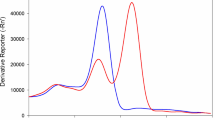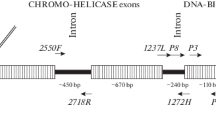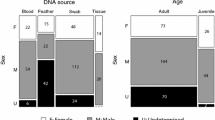Abstract
Background
Ostrich (Struthio camelus) breeds have been gaining increasing significance around the world. The large-scale sex determination of chicks is an important task in the development of these breeds. To date, two PCR-based methods have been established for ostrich sex typing, neither of them intended for large-scale analyses. Here, we report on a protocol adapted to carry out large-scale gender scoring using DNA obtained from chick feathers.
Results
The DNA was extracted using a fast and simple alkaline extraction protocol that provided sufficient template for an early diagnosis. Tests with several primer sets enabled us to determine the best internal control primers associated with the sex-specific primers, avoiding spurious bands. Using DNA extracted from a single bulb and the best set of primers, we applied this protocol to simultaneously sex-type 96 individuals accurately.
Conclusion
We have established a fast, safe, accurate and inexpensive procedure for large-scale sex typing of ostriches using DNA extracted from feathers. This procedure is useful for the gender identification of chicks in the first days of nestling life.
Similar content being viewed by others
Background
In many bird species, it is very difficult to distinguish between males and females based on an analysis of their external morphology, especially young birds. Moreover, every discriminating procedure employed should be safe, accurate, fast and inexpensive. Karyotyping may be a good choice for the sex typing of birds but, unfortunately, the low divergence of Z and W chromosomes precludes this approach in ostriches [1, 2]. On the other hand, conventional techniques to identify the sex of ostriches present significant problems: the animals may suffer stress, since they are subjected to invasive procedures such as endoscopy and cloaca touch. Furthermore, the bird's sex can be identified only in the adult stage, and even then only with a low rate of efficiency (in juvenile birds the rate of error may reach up to around 40%). In the last few years, two reports described PCR-based methods to sex-type ostriches [3, 4]. A method by which small PCR bands are produced, was established by [4]. Another method uses sex-specific primers for a larger female fragment associated with internal standard primers in amplification reactions [3]. Both these methods involved the use of DNA extracted from blood and they were not yet adapted for large-scale analysis. This paper presents an improved protocol, beginning with DNA extracted from feathers bulbs, which can provide sex-identification in the first days of nestling life. Furthermore, we used different control primers to determine the best sets for sex typing and to avoid any kind of spurious band. Finally, we adapted the procedure for use with 96 wells PCR plates, providing a large-scale method.
Results and Discussion
The alkaline extraction used in this work provided a total of approximately 1 μg of DNA from each feather bulb (final concentration about 5 ng/μl), with 2 μl used as template in PCR reactions. In our tests, the reactions using specific female primers associated with L014 microssatellite primers [3] showed an extra band of approximately 500 bp, which was particularly evident in males (Fig. 1A, lane1). This band may lead to misinterpretations, particularly in large-scale analyses, in which males could be identified as females. When associated with female primers, none of the other control primers produced spurious bands (Fig. 1). However, in comparison with the others, the multiplex reactions carried out with OSM5 primers produced more intense and clear amplification bands (Fig. 1A, lane 2 and Fig. 1B, lane 2). Because the SS/OSM5 set provided the best results, it was selected for large-scale analyses. We used this set of primers to sex-type about 100 individuals and verified 100% of accuracy, since the reactions were made in triplicate and the animals' sex was confirmed later by conventional techniques. The DNA extraction on 96 well PCR plates worked well, providing sufficient DNA for PCR and taking less then one hour to complete. Using a steel replicator, the DNA was easily transferred directly to the PCR plate containing the reaction agents. This approach allows not only large-scale analyses but is also useful to prevent cross contamination in PCR and unintentional exchanges of samples, and can be used for other analyses such as parentage tests and others.
Multiplex PCR-based sex-typing tests with specific female and different internal control primer pairs. A: Male samples: M = 1 Kb Marker (Invitrogen); lane 1: SS and L014 pairs; lane 2: SS and OSM5 pairs; lane 3: SS and OSM7 pairs; lane 4: SS and VIAS-OS4 pairs; lane 5: SS and VIAS-OS14 pairs; lane 6: only SS pair. The arrowhead indicates an interference band. B: Female samples: M = 1 Kb Marker (Invitrogen); lane 1: SS and L014 pairs; lane 2: SS and OSM5 pairs; lane 3: SS and OSM7 pairs; lane 4: SS and VIAS-OS4 pairs; lane 5: SS and VIAS-OS14 pairs; lane 6: only SS pair. The arrow indicates female-specific bands.
Conclusions
In this report, we have established a fast, safe, accurate and inexpensive procedure for large-scale sex typing of ostriches using DNA extracted from feathers. The method described here begins with a quick and easy DNA extraction step that dispenses with the use of phenol chloroform. Furthermore, the use of chick feathers provides an early diagnosis that can be adapted for large-scale analyses being useful for the sex identification of chicks in the first days of nestling life.
Methods
Animals
A group of 5-day-old chicks was subjected to sex typing according to [3]. One male and one female individual were selected for the analysis described herein. They were also subsequently sex identified by conventional techniques at 3 months of age. Additional analyses of about 100 individuals were made to verify the reliability and accuracy of the procedure reported herein.
DNA extraction
The DNA template was obtained by rapid simple alkaline extraction [5] from one feather bulb of each preselected individual. The bulbs were submerged in 20 μl of 0.2 N NaOH in a 1.5 ml tube and left in a water bath at 75°C for 20 minutes. The solution was neutralised by adding 180 μl of a 0.04 M Tris-HCl pH 7.5 solution. For large-scale extraction, the feather bulbs were submerged in wells from a 96 well PCR plate containing 20 μl of 0.2 N NaOH (Fig. 2A). The plate was covered with a plastic lid, placed in a PCR machine with the hot lid disabled and the machine set for 75°C, 20 min. (Fig. 2). The neutralisation was then carried out as described above.
Large-scale sex-typing analysis. A: The feather bulbs were submerged in the extraction solution contained on a 96 well PCR plate. B: After the extraction and neutralisation of the reactions, the template DNAs were transferred with a replicator to a novel 96 well PCR plate on which reaction mix had previously been placed. C: The plate was covered and PCR was then carried out. D: The PCR products were subjected to electrophoresis in an agarose gel to determine the animals' sex.
PCR
Specific primers for female fragments SS1 and SS2 [3] (Table 1) were used in each sex-typing PCR reaction. For each tube reaction, one of the standard internal control primer pairs, which amplifies microsatellites regions, was associated with sex specific primers: OSM5 and OSM7 [6]; L014 [7]; VIAS-OS4 and VIAS-OS14 [8] (Table 1). The multiplex PCR reactions were all carried out in a 15 μl volume containing 2 μl of prepared DNA template (approximately 10 ng of DNA), 3 pmol of each primer, 0.5 U of Taq DNA polymerase (Amershan Biosciences), 10 mM Tris-HCl pH 9.0, 1.5 mM MgCl2, 50 mM KCl, and 37,5 μM of each dNTP. For PCR on 96 well plates, 13 μl of this reaction mix was first added to the wells and all the different 96 template DNAs were added simultaneously to the reaction, using a steel replicator (Boeco). The PCR protocol was carried out beginning with a heating temperature of 95°C for 2 min., followed by 30 cycles consisting of 40 s at 94°C, 40 s at 54°C and 1 min. at 72°C, after which a final DNA extension phase was carried out for 5 min. at 72°C. The amplified products were subjected to electrophoresis in 1.5% agarose gel stained with ethidium bromide.
References
Takagi N, Itoh M, Sasaki M: Chromosome studies in four species of Ratitae. Chromosoma. 1972, 36: 281-291.
Ogawa A, Murata K, Mizuno S: The location of Z- and W-linked marker genes and sequence on the homomorphic sex chromosomes of the ostrich and the emu. Proceedings of the National Academy of Science of the USA. 1998, 95 (8): 4415-4418. 10.1073/pnas.95.8.4415.
Bello N, Sánchez A: The identification of a Sex-specific DNA marker in the ostrich using a random amplified polymorphic DNA (RAPD) assay. Molecular Ecology. 1999, 8 (4): 667-669. 10.1046/j.1365-294X.1999.00549.x.
Griffiths R, Orr K: The use of amplified fragment length polymorphism (AFLP) in the isolation of sex-specific markers. Molecular Ecology. 1999, 8 (4): 671-674. 10.1046/j.1365-294X.1999.00578.x.
Rudbek L, Dissing J: Rapid simple alkaline extraction of human genomic DNA from whole blood, buccal epithelial cells, semen and forensic stains for PCR. Biotechniques. 1998, 25: 588-592.
Kimwele CN, Graves JA, Burke T, Hanote O: Development of microsatellite markers for parentage typing of chicks in the ostrich Struthio camelus. Molecular Ecology. 1998, 7 (2): 249-251.
Kumari P, Kemp SJ: Polymorphic microsatellite markers in the ostrich (Struthio camelus). Molecular Ecology. 1998, 7: 133-140.
Ward WK, Mc Partlan HC, Matthews ME, Robinson NA: Ostrich microsatellite polymorphisms at the VIAS-OS4, VIAS-OS8, VIAS-OS22, and VIAS-OS29 loci. Animal Genetics. 1998, 29 (4): 331-
Acknowledgements
We are indebted to Mr. Ariovaldo de Freitas from Fazenda Três Irmãs (Samua Comercial Ltda.), Araraquara, SP, Brazil, for providing the feathers of the animals. DNA Consult Genetics and Biotechnology S/C Ltda., São Carlos, SP, Brazil and the PIPE program from FAPESP supported this work.
Author information
Authors and Affiliations
Corresponding author
Authors’ original submitted files for images
Below are the links to the authors’ original submitted files for images.
Rights and permissions
This article is published under an open access license. Please check the 'Copyright Information' section either on this page or in the PDF for details of this license and what re-use is permitted. If your intended use exceeds what is permitted by the license or if you are unable to locate the licence and re-use information, please contact the Rights and Permissions team.
About this article
Cite this article
Malagó, W., Franco, H.M., Matheucci, E. et al. Large scale sex typing of ostriches using DNA extracted from feathers. BMC Biotechnol 2, 19 (2002). https://doi.org/10.1186/1472-6750-2-19
Received:
Accepted:
Published:
DOI: https://doi.org/10.1186/1472-6750-2-19






